Machu Picchu Ruins, Landmarks and Temples
(Machu Picchu, Peru)
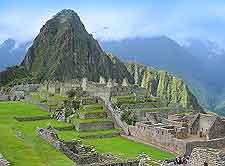
The ancient pre-Columbian site that is the Lost City of the Inca Empire is best known to the world as Machu Picchu, which translates simply as 'Old Mountain'. Machu Picchu is famous outside of
Peru for its well-preserved Inca ruins and mountain terraces, and is known to have been constructed to be the official home of the Inca rulers in the middle of the 15th century, serving as a ceremonial centre for up to 750 residents at any given time.
Standing on a prominent mountain ridge, Machu Picchu overlooks the Urubamba River and now ranks as one of the New Seven Wonders of the World and also as an important World Heritage Site. Just one century after its creation, this Inca site was abandoned and never revealed to the conquering Spaniards, remaining lost to the world for over 350 years. In 1911 Machu Picchu was discovered completely by accident by Hiram Bingham, a historian from the USA, who initially believed it to be the Lost City of Vilcabamba.
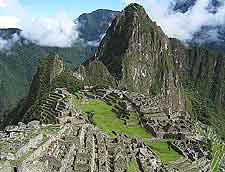
Landmarks, Temples and General Information
Each day, the ruins of Machu Picchu are visited by a maximum of 2,500 people, who come to wander around the temples, admire the craftsmanship of the dry-stone walls, enjoy the endless mountain views, and try to experience the mystery and grandeur first hand.
Machu Picchu itself is open from dawn until dusk, and tends to be at its busiest between 10:00 to 14:00 each day, although those trekking along the
Inca Trail usually arrive at sunrise. Alternatively, early morning buses from nearby
Aguas Calientes are on hand, with July and August predictably being the busiest months.
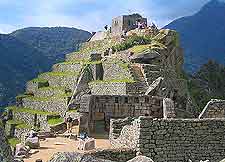
One-day tickets for the site are expensive and must be purchased prior to your arrival, from the Machu Picchu Ticket Office in Aguas Calientes, at the Edificio del Instituto Nacional de Cultura, and are only valid for the actual allocated day.
Tickets are also available from good travel agents, and from tour operators within
Cusco, and should always be purchased well in advance.
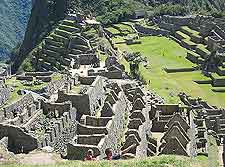
Unless you arrive at the Machu Picchu ruins by trekking along the Inca Trail, you will enter the terraces from their southerly side, passing through a ticket gate and walking along a short footpath.
For the best aerial views and photo opportunities, climb the steep staircase on the left-hand side. A number of large plazas roughly divide Machu Picchu into two particular areas. The main landmarks and Inca temples include the following, in the order they are most likely to be encountered:
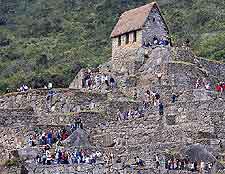 Hut of the Caretaker of the Funerary Rock - now restored, with a thatched roof once more
Hut of the Caretaker of the Funerary Rock - now restored, with a thatched roof once more- Temple of the Sun - the only round building within Machu Picchu, close to the ceremonial baths and the summit
- Royal Tomb - just below the Temple of the Sun, complete with altar and sacred niches
- Sacred Plaza - with viewed platform overlooking the Urubamba River and the Cordillera Vilcabamba
- Temple of the Three Windows - located to one side of the Sacred Plaza, with trapezoidal windows
- Principal Temple - an imposing structure with some damage to one of the corners, caused by soil movement
- House of the High Priest - sited next to Machu Picchu's Principal Temple and close to the Sacristy
- Intihuatana - a major shrine rather like a large sundial, used by Inca astronomers to predict solstices
- Central Plaza - dividing the residential and industrial areas from the ceremonial sector
- Prison Group - something of a labyrinth of cells and passageways, often underground
- Temple of the Condor - featuring a detailed carving of a condor's head
 The ancient pre-Columbian site that is the Lost City of the Inca Empire is best known to the world as Machu Picchu, which translates simply as 'Old Mountain'. Machu Picchu is famous outside of Peru for its well-preserved Inca ruins and mountain terraces, and is known to have been constructed to be the official home of the Inca rulers in the middle of the 15th century, serving as a ceremonial centre for up to 750 residents at any given time.
The ancient pre-Columbian site that is the Lost City of the Inca Empire is best known to the world as Machu Picchu, which translates simply as 'Old Mountain'. Machu Picchu is famous outside of Peru for its well-preserved Inca ruins and mountain terraces, and is known to have been constructed to be the official home of the Inca rulers in the middle of the 15th century, serving as a ceremonial centre for up to 750 residents at any given time.
 One-day tickets for the site are expensive and must be purchased prior to your arrival, from the Machu Picchu Ticket Office in Aguas Calientes, at the Edificio del Instituto Nacional de Cultura, and are only valid for the actual allocated day.
One-day tickets for the site are expensive and must be purchased prior to your arrival, from the Machu Picchu Ticket Office in Aguas Calientes, at the Edificio del Instituto Nacional de Cultura, and are only valid for the actual allocated day. Unless you arrive at the Machu Picchu ruins by trekking along the Inca Trail, you will enter the terraces from their southerly side, passing through a ticket gate and walking along a short footpath.
Unless you arrive at the Machu Picchu ruins by trekking along the Inca Trail, you will enter the terraces from their southerly side, passing through a ticket gate and walking along a short footpath. Hut of the Caretaker of the Funerary Rock - now restored, with a thatched roof once more
Hut of the Caretaker of the Funerary Rock - now restored, with a thatched roof once more